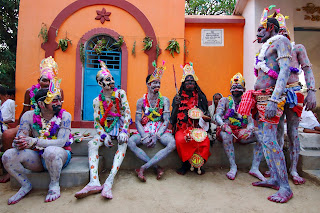12 April 2019, Bardhaman ; Gajan festival or Gajan is a folk festival. Observed during the end of the Bengali calendar, this festival is celebrated mainly in the rural parts of Bengal (West Bengal). The most accepted story of Gajan relates to the conversion of the Buddhist monks to Hinduism. It gradually transformed into a festival of Lord Shiva – the God of Gods (as they said, “Deb’er deb – MohaDeb”). In rural Bengal, there are few places known for its Gajan celebrations. One of them is Kurmun in Bardhaman district, while the other is Krishnadebpur. We visited Krishnadebpur from Kalna.
It is almost impossible to determine the actual period when Gajan started. However , according to some historians , there was a time in middle ages when Buddhism was somewhat cornered in India, Buddhists monks took shelter in many places. One of them was in Bengal where they converted to Hinduism. With them came the Tantric rituals of Buddhism which involving Tantra rituals including severe penance as well as the thought of renouncing worldly pursuits to devote one’s self to spiritual work, which is often referred to as monasticism.
This may be the reason that Gajan started as “Dharmer Gajan” and slowly took its way to “Shiber Gajan” in the later period. In Bengal Dharmathakur is generally worshipped by the scheduled cast like Bauri, Bagdi, Hari, Dom. Dharmathakur may have been originated from Dharmaraj of Buddhism. Although Dharmathakur is identified by a shapeless stone (as seen in Bankura) and its Vahana is represented by terracotta horses , there have been instances where Buddha idol has been worshipped as Dharma Thakur in villages of Bankura.There are still villages where both Dharamraj and Shiva are placed with Gajan offerings.
It is almost impossible to determine the actual period when Gajan started. However , according to some historians , there was a time in middle ages when Buddhism was somewhat cornered in India, Buddhists monks took shelter in many places. One of them was in Bengal where they converted to Hinduism. With them came the Tantric rituals of Buddhism which involving Tantra rituals including severe penance as well as the thought of renouncing worldly pursuits to devote one’s self to spiritual work, which is often referred to as monasticism.
This may be the reason that Gajan started as “Dharmer Gajan” and slowly took its way to “Shiber Gajan” in the later period. In Bengal Dharmathakur is generally worshipped by the scheduled cast like Bauri, Bagdi, Hari, Dom. Dharmathakur may have been originated from Dharmaraj of Buddhism. Although Dharmathakur is identified by a shapeless stone (as seen in Bankura) and its Vahana is represented by terracotta horses , there have been instances where Buddha idol has been worshipped as Dharma Thakur in villages of Bankura.There are still villages where both Dharamraj and Shiva are placed with Gajan offerings.

Very good, keep it up.
ReplyDeleteThanks a lot
Delete